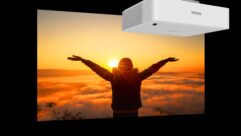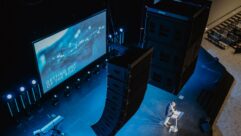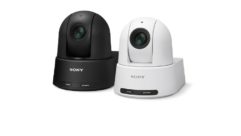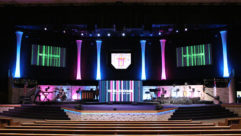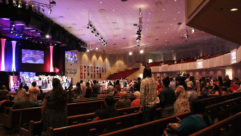Keeping the Faith
Apr 1, 2002 12:00 PM,
By Gregory DeTogne
A little more than a decade ago, St. Mary of the Angels church was on the skids, suffering from prolonged neglect and a dwindling congregation. Left all but dark and abandoned on Chicago’s north side after serving local parishioners for nearly a century, the traditional Roman Catholic house of worship nonetheless made a remarkable recovery, and by the late 1990s an extensive restoration of its lavishly ornate interior was being completed.
Grand, cathedral-like and inspired by the works of Renaissance master painters and architects, the church’s renovated sanctuary never fails to give pause to those who enter. From the nave, soaring gilded columns rise to a ceiling that bears expansive hand-painted murals painstakingly brought back to their original splendor by European craftsmen laboring for months high atop steel scaffolds. Serving diverse gatherings of the faithful, the church is alive and well once again, and you can hear Sunday mass in English, Spanish and Polish.
As a basic component of the rebirth of St. Mary of the Angels, sound reinforcement has played a vital and sometimes troublesome role. The church had wanted to keep the sanctuary’s dramatic interior as undisturbed as possible, and so it commissioned the building of an audio system grossly undersized for the job.
Jim Brown of Chicago-based Audio Systems Group Inc. explained that the principle challenges in designing the sound system stemmed from the cavernous space inside the church. Brown’s consulting firm was responsible for devising an initial plan back in 1994, aimed at remedying the sanctuary’s sonic woes and developing the second DSP-based upgrade implemented late last year. “Given the structure’s size and scope, it should come as no surprise that its basic acoustical problems are associated with high levels of reverberation,” Brown said. “To compound matters, the room is also plagued by long reverberation times. When I first examined the environment, the sound system was comprised of extremely small loudspeakers that were easy to conceal but did little to provide the pattern control needed to tame the reverberation.”
Nearly a decade ago, with the aid of EASE modeling, Brown penned a new design for the sanctuary. The design was implemented by RC Communications, a systems integration firm in nearby Schiller Park. Because of the room’s long reverberation times, his blueprint provided very careful pattern control to minimize the spill of sound into the reverberant environment throughout the voice range. He also planned to reuse as much of the existing system’s electronics and wiring as possible to honor the budget.
At the heart of the design was a pair of two-way, Renkus-Heinz CBH400-9 large-format 90-by-40-degree horns coupled with CDT-1 co-entrant drivers and their own passive crossovers. Offering good pattern control to below 500 Hz, the horn/driver combinations were chosen because they are suitable for both speech and music. Installed high above the congregation to the left and right, the loudspeaker systems shared space above the sanctuary floor with a pair of custom 4-element, directional bass arrays that operated in the octave below each horn. As a further enhancement to the system’s vocal qualities, the bass arrays bring focus to the lows in the same manner that the horns do for the mids and highs, providing the natural body of the human voice that couldn’t be controlled by the horns alone.
To bring sound reinforcement to the nave, Brown used three pairs of custom column-mounted line arrays, each employing a dozen 3-inch cone loudspeakers. Four identical copies of these arrays were mounted in an antiphonal balcony at the rear of the church: One pair provides reinforcement for a separate cantor system, and the other serves as foldback for the choir. House mixing functions received a new lease on life with the addition of a pair of SCM810 automatic mixers from Shure. For the few occasions when a manual mix was required in the house, a Mackie 16-channel 1604-VLZ mixer was kept at hand behind a locking hinged panel at the rear of the balcony.
As planned, Brown’s first system upgrade at the church was completed successfully without purchasing new power amplifiers, equalizers or delays. All of the loudspeaker wiring was reused as well. Spatially reorganized within existing rack real estate to compensate for the changes, most of the reused electronics maintained their former roles. An assortment of Altec power amps (four model 9444Bs and a pair of model 9442s) fueled the system. EQ arrived through Ashly GQX3101 1/3-octave units and Rane2/3-octave stereo GE215s, and Yamaha D1030 processing was employed for both delay and crossover functions, as required. Williams hearing assistance was neatly packaged at the top of one of the equipment racks.
Following the revamped system’s debut, everyone — multilingual congregation included — was left smiling. The rig performed admirably in its upgraded configuration until 2001, when a unique opportunity presented itself, allowing the church to further refine its sound.
FURTHER ASCENSION
on october 11, 2001, Gold Line‘s TEF Level II Workshop on Intelligibility came to Chicago. Directed by Columbia College professor Doug Jones (see “AI to PASTI” on page 56), the seminar was cosponsored by Brown’s Audio Systems Group along with RC Communications, Shure Incorporated and TOA.
“Immediately I realized that St. Mary of the Angels would be an ideal location to host some of the workshop activities,” Brown said. “It was certainly acoustically challenging enough. The only problem standing in our way was the electronics. Although they still worked okay, they were incapable of quickly changing the delay, equalization and other parameters of the system, which we’d need to do. We had carefully designed the system so that there was no echo returning from the rear of the church. During the workshop, however, we had to simulate an echo coming from the back wall using the custom line arrays in the balcony to illustrate how a rear-wall reflection could destroy intelligibility. We needed more control over the system, and the only way it could be achieved practically and affordably was through the use of digital signal processing.”
As luck would have it, Shure Incorporated came to Brown’s rescue with two of its P4800 digital system processors. Easy enough to use that most people have it up and running without ever cracking the manual, the P4800 employs an intuitive drag-and-drop architecture offering control over just about any processing function between the mixer and amplifiers within installed systems. Among the features found on each unit is a 4-by-8 matrix mixing section that enables users to assign any of its four inputs to any of the eight outputs, with provisions for adjusting levels and signal polarity along the way. With the click of a mouse, processing blocks can be added to the signal path, including several EQ options, automatic gain control, limiting, compression, gates, delay, dynamics processing and Shure’s patented DFR feedback reducer. Processing blocks can be copied to any input or output to duplicate processing across multiple channels.
Over the years, administrators at St. Mary of the Angels trusted Brown to help develop their sound. When he showed them the Shure DSP box and told them of his latest plans, they kept that faith, giving their full blessings to his new proposal.
“Beyond the workshop’s needs, I felt there was a real value for the church to make the switch to the Shure DSP box,” Brown said. “Because it was a brand-new product, they would be turning the hours on their reliability clock back to zero and starting fresh for a big portion of the system. They’d also free up a lot of rackspace. And more important, from a tuning standpoint, we would be able to take the system to a new level of refinement that simply wasn’t possible with the aging analog gear.”
Given the green light for the project, Brown recruited Ron Steinberg, principal and chief engineer of RC Communications, to remove the old analog gear and install the P4800s. “Ron’s always been ready to contribute to any project from which he and his staff can learn,” Brown said of his long-time colleague. Once the Shure DSP processors were in place, Steinberg and Brown re-tuned the system for the church’s everyday use. Working from a spot by the altar, they accessed the P4800’s RS-232 remote control-port from a laptop via 50-foot cable runs leading through an opening in the sanctuary ceiling directly to the equipment racks.
“The real beauty of this device when it comes to tuning is the level of control you gain over equalization,” Brown said. “As we all know, when you EQ a system, you start by tuning it flat, and then you tailor it from there until it sounds just right. With the P4800, you can make your finely detailed, subjective tweaks without affecting your basic tuning, because you can add separate bands of additional EQ and then simply leave it there. The settings can be password-protected, too, at multiple levels for different users.”
From a maintenance and service standpoint, Brown also notes that the P4800 has given Ron Steinberg and his RC Communications crew — the ongoing service providers to the client — less to worry about. “The unit is totally contractor friendly,” he said. “Armed with the right password, you can walk right up to it and download all the settings. The one-size-fits-all nature of the box allows you to maintain spares just by keeping two in reserve.”
Brown completed his second St. Mary of the Angels system upgrade by collecting new EASE data, using much more advanced software than he had used eight years before. “The new work we did in EASE allowed us to take a second look at the design in greater detail,” he said. “We confirmed the accuracy of our predictions beyond anything conceivable back when I first walked into this space. Now, it’s evident the performance of the system in general has been improved upon as much as the new processing technology will allow. We could always be tweaking something if we wanted to. But, offhand, I’d say the congregation is set for some time to come.”
Gregory DeTogne is a writer, communications consultant and owner of an editorial public relations firm in Libertyville, Illinois, specializing in pro audio accounts.
Angelic Sounds
This EASE 4.0 model of St. Mary of the Angels Church was prepared by Ron Sauro. The church didn’t have real blueprints, so Sauro worked from poor quality, reduced-size copies of blueprints that couldn’t be scaled, digital photos and dimensioned sketches prepared by tape measure.
The room model is detailed and quite accurate in the lower half of the room (below the top of the choir balcony) but has only a first order approximation in the top half of the room and in the altar area. This is a reasonable strategy for a loudspeaker system that is located entirely in the well-detailed part of the room and carefully concentrates its energy on congregation seating. Low-order reflections having significant energy are accurately computed, and the higher order reflections that contain less energy are accounted for using reverberation statistics.
Mapping with EASE
The figure to the left shows how direct sound from one of the two large horns covers the front third of the church. The elevated rectangles above the floor represent the listening plane, or average ear-level, of the seated congregation. Direct sound is mapped both to these seating planes and to the real wall surfaces.
This is a large EASE model; even on a fast computer, it can take a while to get a detailed plot of performance everywhere in a room. But many design tasks don’t require that. This computation (which took only a minute or so) was used to aim the horn and study both its coverage of the congregation and spill to wall surfaces. EASE can be set to look at any combination of wall surfaces with any combination of loudspeakers.
The model shows that the horns cover quite well to the first column and begin to fall off beyond it. Therefore, delayed loudspeakers are needed to provide coverage beyond the first column. Note that the horns are carefully aimed so that they do not spill to the marble floor in front of the pews. Moreover, because they are aimed low, very little of their energy can hit the rear wall or balcony face and come forward as echo.
This plot and subsequent plots of delayed loudspeaker coverage clearly demonstrate the wisdom that the front faces of the architectural columns should be covered with acoustic absorption, starting above the pews and extending upwards for roughly 8 feet. The church is far too reverberant, even for baroque organ music, so a modest reduction in reverberation is certainly in order. In fact, a case could be made for light carpet in the aisles to reduce activity noise and reduce the first reflection from the horns.
Church Revival:
Revitalized after years of disuse, St. Mary of the Angel’s church now shines once again in north Chicago.
Nice and Ease-y:
Here is the direct sound coverage by the first delayed line array on the left side of the congregation. Note that it begins providing coverage about 6 feet from the array, which is just about where the horns are falling off. Note also that the very narrow vertical directivity of the line array, and the fact that it is tilted down by about 15 degrees, keeps its energy low in the room. That means that any first order reflection will also be low in the room, and for the most part be grounded to the pews.
EASE is using a complex (magnitude and phase) computation for the 12 drivers that make up the line array. This computation is only a first approximation of reality, because the directional data is for a different driver than was actually used. Computed results do compare reasonably well with actual system performance, however. That’s because the complex computation of all the individual drivers is valid for both the near field and far field. (In EASE, this calculation is called an “interference sum.”) The perspective here is from the viewpoint of the horn on the other side of the room (any point in the room can be used — this one was chosen because it gives a good perspective on coverage).
A Classic Dilemma:
Domed church ceilings look striking from the outside, and they inevitably present sound-sytem challenges.
For More Information
Altec
altecmm.com
Circle 215 on Reader Service Card
Ashly
ashly.com
Circle 216 on Reader Service Card
Ease
ada.acousticdesign.de
Circle 217 on Reader Service Card
Gold Line/TEF
gold-line.com
Circle 218 on Reader Service Card
Mackie
mackie.com
Circle 219 on Reader Service Card
Rane
rane.com
Circle 220 on Reader Service Card
Renkus-Heinz
renkus-heinz.com
Circle 221 on Reader Service Card
Shure
shure.com
Circle 222 on Reader Service Card
Telex
telex.com
Circle 223 on Reader Service Card
TOA
toeelectronics.com
Circle 224 on Reader Service Card
Williams Sound Corp.
williamssound.com
Circle 225 on Reader Service Card
Yamaha
yamaha.com
Circle 226 on Reader Service Card


